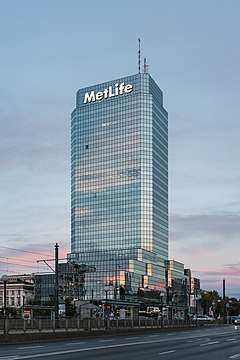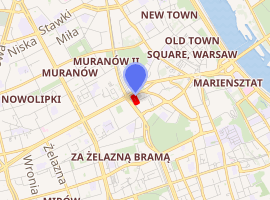Błękitny Wieżowiec
Błękitny Wieżowiec (literally Blue Skyscraper) is a building located in Bank Square in Warsaw. It stands in the place that was occupied before World War II by Warsaw's largest synagogue, the Great Synagogue,[1] which was blown up by the Germans in 1943. Initial concepts for the construction of the skyscraper had been put forward in the 1950s, but construction finally began in the 1970s and was suspended shortly after the main structure was built. The unused construction was then often called the "golden towers" because of the colour of the facade.
| Błękitny Wieżowiec | |
|---|---|
 | |

| |
| Former names | Złoty Wieżowiec (Golden Tower) |
| General information | |
| Location | Warsaw, Poland |
| Address | Plac Bankowy 2, Śródmieście |
| Construction started | 1976 |
| Completed | 1991 |
| Height | 120m |
| Technical details | |
| Floor count | 27 |
| Floor area | 23,545m² |
| Design and construction | |
| Architect | Jerzy Czyż, Andrzej Skopiński, Jan Furman, Lech Robaczyński, Marzena Leszczyńska |
The work resumed in the late 1980s and was completed in 1991. The project was modified by a Belgrade-based company, replacing the copper-coloured facade with colourless reflective material, which gives a sky-blue reflection on a clear day (hence the current name). The skyscraper is 120 meters high and has 28 storeys. Prominent former tenants include Peugeot and Sony which had large neon signs on the building.
| Wikimedia Commons has media related to Blue Skyscraper. |
References
- "Błękitny Wieżowiec (dawniej Wielka Synagoga)" (in Polish). 2012-05-19. Archived from the original on 2014-08-04. Retrieved 2015-04-07.